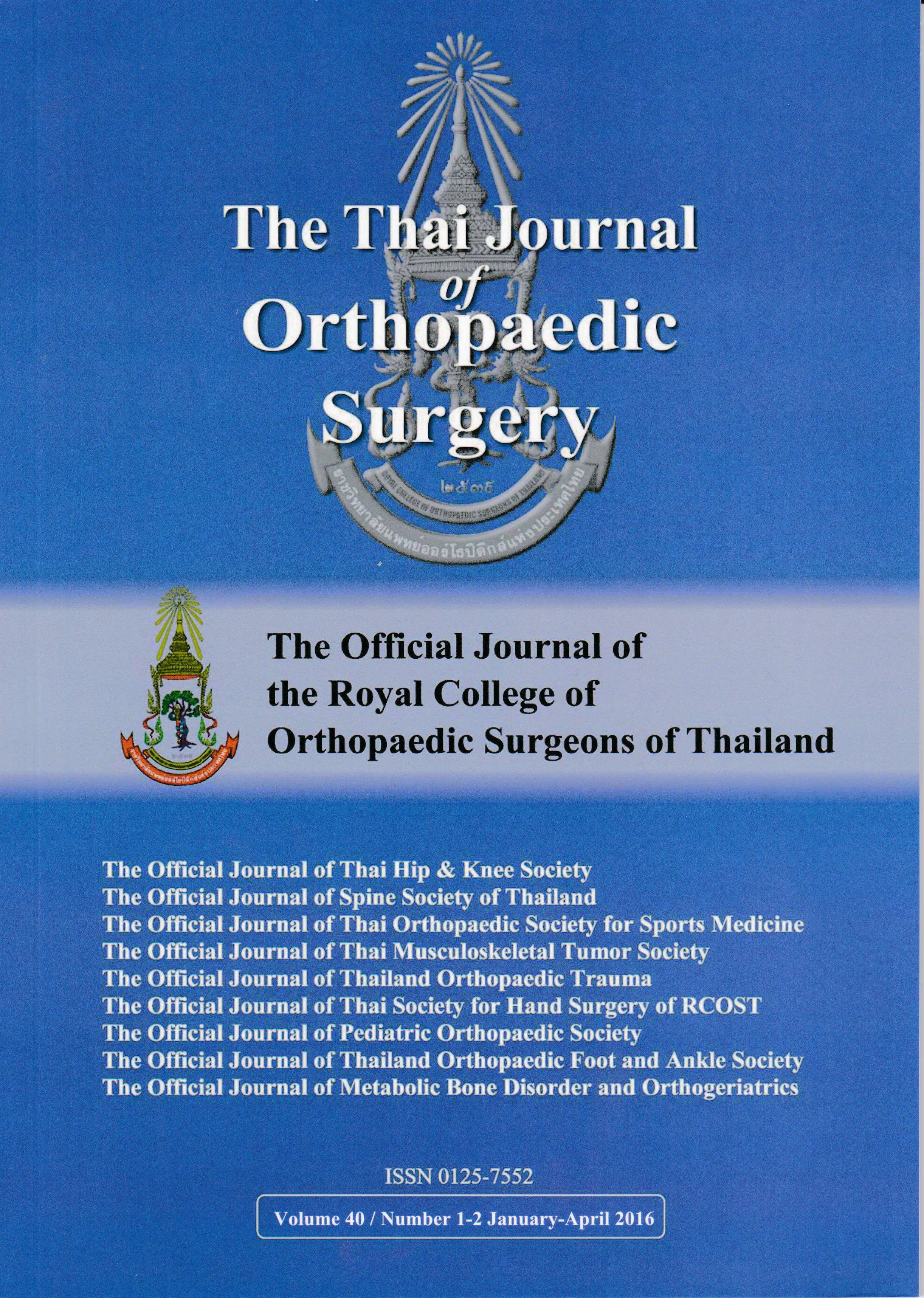Cost Analysis of Blood Transfusion and Tranexamic acid in Primary Total Knee Arthroplasty
Main Article Content
Abstract
Purpose: To determine transfusion rates and trends of allogenic blood transfusion in total knee arthroplasty patients and to analyze the cost of blood transfusions in TKA.
Methods: This study was a non-randomized retrospective study that included 342 osteoarthritis knees which underwent unilateral primary TKA from June, 2012 through June, 2014. The patients were categorized into 2 groups; group 1 were treated with tranexamic acid and group 2 received no treatment with tranexamic acid. All surgeries were performed in the Department of Orthopedics, Police General Hospital. The data of blood transfusion was collected from blood bank by software “BloodTrans” and the cost of blood transfusions were collected from the Pharmaceutical and Financial Department, Police General Hospital.
Results: 342 total knee arthroplasty patients were included. The male:female ratio was 80:262. The average age was 68.74 (50-84) years. The average weight was 67.0 (58-90) kilograms. The average height was 163 (160-172) cm. The average BMI was 25.21(22.2-28.5) kg/m2, the number of knees (right:left) were 216:126. The average level of preoperative Hct in group 1 was 36.40 % (30-44.5) and in group 2 was 38.7 % (30-43.5). The average level of postoperative Hct in group 1 was 31.4 % (26-40.5) and group 2 was 30.1 % (23-38.5). The overall number of patients who received blood transfusions was 164 (48%): in the tranexamic group 54 patients (36%) and 110 patients (58%) in the non-tranexamic acid group. The total number of blood units transfused was 233 units, and the overall average number of units received per patient was 0.68 units: in group 1 the average was 0.47 units and 0.85 units in group 2. The total cost of blood transfusions was 174,300 baht. The average cost of per blood transfusion was 530 baht per TKA: in the tranexamic group 463 baht (12% lower than average costs) and 584 baht (10% higher than average costs) in the non-tranexamic acid group.
Conclusions: The average number of units of blood transfused was lower than standard blood transfusions. But, the transfusion rate was higher than the standard treatment. The tranexamic group had lower transfusion rates and costs of blood transfusions compared to the non-tranexamic acid group. The use of tranexamic acid continues to rise and shows positive results. The indication of blood transfusions need to be evaluated with the appropriate criteria.
Article Details
References
2. Nielsen HJ. Detrimental effects of peri-operative blood transfusions. Br J Surg 1995; 82: 582-7.
3. Hill et:Allogenic blood transfusion increase risk of postop bacterial infection, meta-analysis J of trauma 2003.
4. Nadler SB, Hidalgo JU, Bloch T. Prediction of blood volume in normal human adults. Surgery 1962; 51: 224-32.
5. Benoni G, Fredin H. Fibrinolytic inhibition with tranexamic acid reduces blood loss and blood transfusion after knee arthroplasty: a prospective, randomized, double-blind study of 86 patients. J Bone Joint Surg [Br] 1996; 78-B: 434-40.
6. Hiippala S, Strid L, Wennerstrand M, et al. Tranexamic acid (Cyklokapron) reduces peri-operative blood loss associated with total knee arthroplasty. Br J Anaesth 1995; 74: 534-7
7. Zohar E, Fredman B, Ellis MH, et al. A comparative study of the postoperative allogenic blood-sparing effects of tranexamic acid and after total knee replacement. Transfusion 2001; 41: 1285-9.
8. Wang GJ, Hungerford DS, Savory CG, et al. Use of fibrin sealant to reduce bloody drainage and haemoglobin loss after total knee arthroplasty: a brief note on a randomized prospective trial. J Bone Joint Surg [Am] 2001; 83-A: 1503-5.
9. Levy O, Martinoqitz U, Oran A, Tauber C, Horoszowski H. The use of fibrin tissue adhesive to reduce blood loss and the need for blood transfusion after total knee arthro-plasty: a prospective, multi-centre study. J Bone Joint Surg [Am] 1999; 81-A: 1580-8.
10. Agletti P, Baldini A, Vena LM, et al. Effect of tourniquet use on activation of coagulation in total knee arthroplasty. Clin Orthop 2000; 371: 169-77.
11. Thana Turajane, Viroj Larbpiboonpong, Samart Maungsiri. Results of Computer Assisted Mini-incision Subvastus Approach for Total Knee Arthroplasty, Journal of The Medical Association of Thailand 2009; 92: 45-50.
12. Samart Maungsiri ,Thana Turajane,Viroj Larbpiboonpong, Clinical Outcomes of Subvastus Approach for Minimally Invasive Total Knee Arthroplasty, Journal of The Medical Association of Thailand 2009; 92: 75-89.
13. J.A. Karam, M.R. Bloomfield, T.M. DiIorio. Evaluation of the Efficacy and Safety of Tranexamic Acid for Reducing Blood Loss in Bilateral Total Knee Arthroplasty. The Journal of Arthroplasty 2014; 29: 501–503


